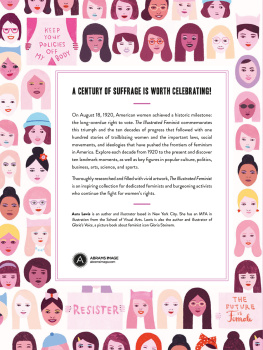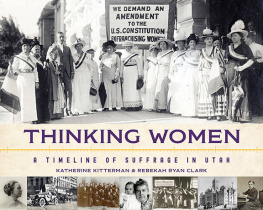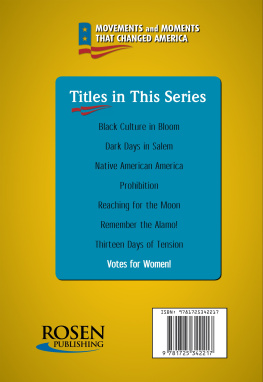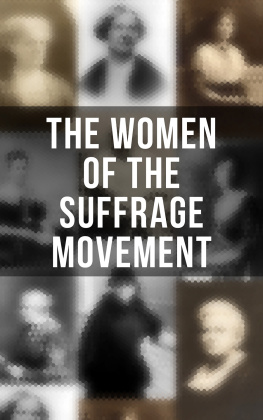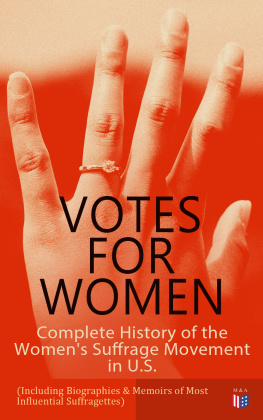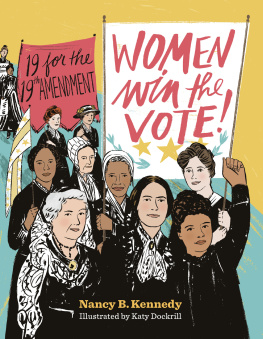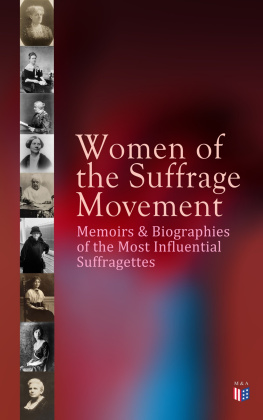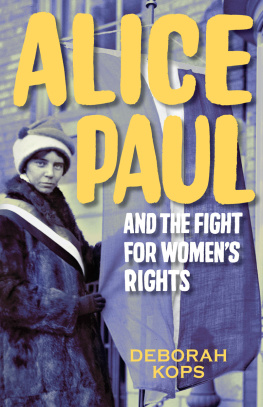Votes and More
for Women:
Suffrage and After
in Connecticut
Votes and More
for Women:
Suffrage and After
in Connecticut
Carole Nichols
Votes and More for Women: Suffrage and After in Connecticut has also been published as Women & History, Number 5, Spring 1983.
Copyright 1983 by The Haworth Press, Inc. All rights reserved. Copies of chapters in this work may be reproduced noncommercially for the purpose of educational or scientific advancement. Otherwise, no part of this work may be reproduced or utilized in any form or by any means, electronic or mechanical, including photocopying, microfilm, and recording, or by any information storage and retrieval system, without permission in writing from the publisher.
First published by:
The Haworth Press, Inc., 28 East 22 Street, New York, NY 10010
This edition published 2012 by Routledge:
| Routledge | Routledge |
| Taylor & Francis Group | Taylor & Francis Group |
| 711 Third Avenue | 2 Park Square, Milton Park |
| New York, NY 10017 | Abingdon, Oxon OX14 4RN |
Library of Congress Cataloging in Publication Data
Nichols, Carole.
Votes and more for women.
Also... published as Women & history, number 5, spring 1983T.p. verso.
Bibliography: p.
Includes index.
1. WomenSuffrageConnecticutHistory. 2. FeminismConnecticutHistory.
I. Title.
JK1911.C8N52 1983 324.62309746 83-8405
ISBN 0-86656-192-7
EDITOR: ELEANOR S. RIEMER
ASSOCIATE EDITOR: ALICE MILLER
CONTRIBUTING EDITOR: LOIS BANNER
BOARD OF ADVISORS
PHYLLIS ANDORS, Wagner College
LOIS BANNER, George Washington University
RENATE BRIDENTHAL, Brooklyn College, City University of New York*
SANDI COOPER, College of Staten Island, City University of New York*
LEONORE DAVIDOFF, University of Essex, England
ELIZABETH FOX-GENOVESE, State University of New York, Binghamton
BARBARA HARRIS, Pace University*
DOROTHY HELLY, Hunter College, City University of New York*
BARBARA S. KANNER, Occidental College
ALICE KESSLER-HARRIS, Hofstra University
GERDA LERNER, University of Wisconsin
KATHLEEN McCRONE, University of Windsor, Canada
JOANN McNAMARA, Hunter College, City University of New York*
MARY BETH NORTON, Cornell University
SARAH POMEROY, Hunter College, City University of New York*
ANNE FIROR SCOTT, Duke University
JOAN SCOTT, Brown University
CARROLL SMITH-ROSENBERG, University of Pennsylvania
ROSALYN TERBORG-PENN, Morgan State University
MARCIA WRIGHT, Columbia University*
*A Fellow of the Institute for Research in History
About the Author
Carole Nichols is currently Coordinator of the Women's History Program at Sarah Lawrence College, where she earned an M.A . in Women's History in 1979. She and Joyce Pendery recently completed a two-year oral history project, The Political Activities of the First Generation of Fully Enfranchised Connecticut Women, funded by the Connecticut Humanities Council under the auspices of the University of Connecticut at Storrs.
Foreword
During a decade or more of vigorous scholarship in women's history, the suffrage movement has been curiously overlooked. Despite its centrality to women's organizational activity, the century-long attempt to secure the vote for women awaits its modern chroniclers. The reasons for this oversight are several. The publication of a number of impressive works on the subject in the late 1950s and 1960s seemed to preempt the necessity for further investigation. More important, the prevailing view of earlier historians that suffrage was all there was to women's history provoked newly-emerging historians of women and motivated them to probe the depths of women's experience in all areas of life. Suffrage was relegated to secondary consideration. Yet the movement for the vote, more than any other, linked women around a common cause and brought together the disparate meanings of their social involvements. It is high time for a reinterpretation of suffrage as an integrative experience in the light of the impressive scholarship on women during recent years.
Focusing on the state of Connecticut, Carole Nichols has written a significant chapter in the final suffrage narrative. Most important, her conclusions suggest a version somewhat different from the current conception. Attending to the state rather than the national level, Nichols finds a unified movement of womennot only during the Progressive era of suffrage achievement but also during the 1920s, when women's organizations are generally presumed to have fallen into a self-defeating factionalism which doomed further reform endeavor. There was no split in Connecticut, for example, between the League of Women Voters and the Woman's Party. Both remained largely autonomous from the national organization, and together they pursued a vigorous program, including demands for juvenile courts, maternity and health care, birth control, and women's rightsboth before and after the war. If anything, the conservative Republican Party which controlled the state government confounded women's attempts at reformboth in the Progressive era and in the 1920s.
See Eleanor Fiexner, Century of Struggle: The Woman's Rights Movement in the United States (New York, 1959); Aileen S. Kraditor, The Ideas of the Woman Suffrage Movement, 1890-1920 (New York, 1965); William L. O'Neill, Everyone Was Brave: The Rise and Fall of Feminism in America (New York, 1969).
Nichols's research raises interesting questions about the locus of authority within American women's voluntary organizations, about the generational continuity and discontinuity among groups of American women, about the whole interpretation of the 1920s as the roaring twenties, dominated by sex and speakeasies and the rejection of the Progressive crusade for social justice. Along with recent works by Susan Becker and Lois Scharf, Nichols brings the politics of women's organizations into closer perspective and suggests that the feminism of the 1910s endured into the 1920s in ways historians have not paid full attention to. And she strongly suggests that we should shift our prevailing attention from the national to the state level if we are fully to assemble the puzzle of the seeming failure of women's reform action after the passage of suffrage. There we may find that women were not in fact unintentional culprits in feminism's demise but rather victims of forces dominated by men over which they had no control.
Lois W. Banner
Professor of History
George Washington University
Washington, DC
Susan Becker, The Origins of the Equal Rights Amendment: American Feminism Between the Wars (Westport, CT, 1981); Lois Scharf, To Work and To Wed: Female Employment, Feminism, and the Great Depression (Westport, 1980).


